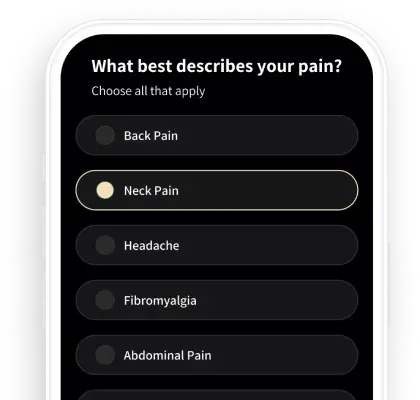Science-backed pain relief. Honestly priced.
Pain shouldn’t cost your peace or your paycheck. We’ve been there — and that’s why PainApp is priced with empathy and fairness.
After your free trial ends, it’s just $34.99 every 3 months. Cancel anytime — no obligations, no hidden fees.
What’s included
Our app guides you through a science-backed method to break the chronic pain cycle. Based on the latest research in neuroscience and predictive coding, we help you identify brain-generated pain (neural circuit pain) and rewire the fear-based patterns keeping it alive.

Your Personal Pain doctor
Pain isn’t just physical—it’s personal. That’s why PainApp gives you a dedicated pain doctor to help you navigate and reduce chronic pain using neuroscience-based strategies. With guidance, relief is always within reach.

Therapeutic neuroscience education
Pain isn’t just physical—it’s personal. That’s why PainApp gives you a dedicated pain doctor to help you navigate and reduce chronic pain using neuroscience-based strategies. With guidance, relief is always within reach.
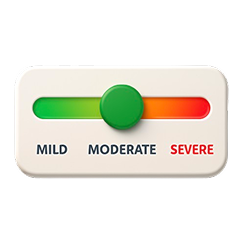
Pain tracking
Track your pain, discover insights, and receive personalized safety messages to improve your well-being. Our app empowers you to take control of your chronic pain by identifying patterns, triggers, and effective management strategies.
We believe in science
Decades of studies show that chronic pain is often a learned brain response — not a sign of damage. And more importantly: that your brain can unlearn it.
Your Brain Can Learn Pain — and Unlearn It
“Pain Reprocessing Therapy significantly reduced or eliminated chronic pain by teaching patients to reinterpret it as harmless brain activity.” — JAMA Psychiatry, 2022
Summary: This study clearly shows that chronic back pain is often generated by the brain, not due to ongoing physical damage. Pain Reprocessing Therapy (PRT), which teaches patients to reinterpret their pain as harmless brain activity, significantly reduced or eliminated pain for most patients, with lasting effects even a year later. Brain scans confirmed that changing beliefs about pain also changed brain activity, further proving that chronic pain can be managed by retraining the brain.
APA Citation: Ashar, Y. K., Gordon, A., Schubiner, H., Uipi, C., Knight, K., Anderson, Z., … Wager, T. D. (2022). Effect of pain reprocessing therapy vs placebo and usual care for patients with chronic back pain: a randomized clinical trial. JAMA Psychiatry, 79(1), 13–23.
Phantom Pain Proves It’s Brain-Generated
“Phantom limb pain is a powerful example of the brain generating pain without any physical injury.” — Nature, 1995
Summary: Phantom limb pain occurs when the brain continues to generate pain signals despite the limb being gone. This research found a strong link between brain reorganization and the intensity of phantom limb pain, clearly demonstrating the brain’s active role in creating pain sensations without any physical injury.
APA Citation: Flor, H., Elbert, T., Knecht, S., Wienbruch, C., Pantev, C., Birbaumer, N., … Taub, E. (1995). Phantom-limb pain as a perceptual correlate of cortical reorganization following arm amputation. Nature, 375(6531), 482–484.
Your Nervous System Can Keep Pain Alive
“Even after an injury heals, your brain and spinal cord can stay on high alert — keeping pain going.” — Pain Journal, 2011
Summary: This review shows that the central nervous system, including the brain, can amplify and maintain pain through a process called central sensitization. Even when initial injuries have healed, this mechanism keeps pain ongoing and intense. This highlights that many chronic pain conditions are driven by brain activity rather than physical injuries alone.
APA Citation: Ashar, Y. K., Gordon, A., Schubiner, H., Uipi, C., Knight, K., Anderson, Z., … Wager, T. D. (2022). Effect of pain reprocessing therapy vs placebo and usual care for patients with chronic back pain: a randomized clinical trial. JAMA Psychiatry, 79(1), 13–23.
Pain Can Be a Prediction, Not a Reaction
“Chronic pain can persist because the brain expects it — not because anything is still wrong.” — Behavioral and Brain Sciences, 2013
Summary: Our brains constantly predict and interpret sensory information, often creating sensations like pain based on expectation rather than actual tissue damage. This predictive processing explains how chronic pain can persist without injury, as the brain maintains an incorrect expectation of pain, reinforcing a cycle of ongoing discomfort.
APA Citation: Clark, A. (2013). Whatever next? Predictive brains, situated agents, and the future of cognitive science. Behavioral and Brain Sciences, 36(3), 181–204.
Beliefs and Emotions Shape Pain
“The brain’s emotional and evaluative systems can create or reduce pain based on how we feel and what we expect.” — Annual Review of Clinical Psychology, 2017
Summary: This article demonstrates how the placebo effect, powered by beliefs and expectations, can significantly alter pain experiences. The brain, through its emotional and evaluative processes, can create or reduce pain based purely on psychological appraisals, underscoring that chronic pain can be heavily influenced or generated by the brain.
APA Citation: Clark, A. (2013). Whatever next? Predictive brains, situated agents, and the future of cognitive science. Behavioral and Brain Sciences, 36(3), 181–204.
MRI Findings Don’t Always Mean Pain
“Many people with disc degeneration or bulges on MRI have no pain at all — the brain matters more.” — AJNR, 2015
Summary: This review revealed that many people without pain have spinal abnormalities seen on MRI scans, such as disc bulges or degeneration. These findings demonstrate that such imaging results often do not cause pain, pointing to the brain’s central role in generating chronic pain independently of these structural changes.
APA Citation: Brinjikji, W., Luetmer, P. H., Comstock, B., Bresnahan, B. W., Chen, L. E., Deyo, R. A., … Jarvik, J. G. (2015). Systematic literature review of imaging features of spinal degeneration in asymptomatic populations. American Journal of Neuroradiology, 36(4), 811–816.
Central Sensitization Keeps Pain Alive
“Your nervous system can stay stuck in ‘danger mode’ long after an injury heals — that’s central sensitization.” — — Mayo Clinic Press
Summary: Central sensitization occurs when the brain and spinal cord become overly sensitive and hyper-reactive, amplifying pain signals even without ongoing tissue damage. This brain-driven process explains why some people experience chronic pain persistently and intensely. It highlights how chronic pain can be maintained and intensified solely by the nervous system, emphasizing the critical role of brain-based mechanisms in chronic pain.
APA Citation: Mayo Clinic Press. (n.d.). What is central sensitization and how does it relate to pain? Retrieved May 12, 2025, from https://mcpress.mayoclinic.org/living-well/what-is-central-sensitization-and-how-does-it-relate-to-pain/
Pain Can Stay Long After Injuries Heal
“Even when your body is fine, your brain may still be sending danger signals — keeping pain alive.” — — Cleveland Clinic
Summary: This overview from Cleveland Clinic emphasizes that chronic pain, lasting over three months, can persist long after injuries heal or even without clear injuries. It describes central sensitization, where the nervous system becomes overly sensitive, amplifying pain sensations. This article highlights how chronic pain can be driven by brain and nervous system processes rather than physical issues alone, underscoring the brain’s critical role in pain persistence.
APA Citation: Cleveland Clinic. (n.d.). Chronic pain: What it is, symptoms, treatment & management. Retrieved May 12, 2025, from https://my.clevelandclinic.org/health/diseases/4798-chronic-pain
Emotional Processing Can Reduce Pain
“Addressing emotions can lead to more pain relief than traditional therapy — and the science proves it.” — — Pain Medicine, 2020
Summary: This study found Emotional Awareness and Expression Therapy (EAET), which focuses on addressing unresolved emotional issues, significantly reduced chronic musculoskeletal pain more effectively than Cognitive Behavioral Therapy (CBT). By directly targeting emotional processing, EAET demonstrated that chronic pain often involves emotional conflicts wired into brain pathways. Addressing these emotions can profoundly reduce pain, supporting the role of the brain and emotional health in chronic pain management.
APA Citation: Yarns, B. C., Lumley, M. A., Cassidy, J. T., Steers, W. N., Osato, S., Schubiner, H., & Sultzer, D. L. (2020). Emotional awareness and expression therapy achieves greater pain reduction than cognitive behavioral therapy in older adults with chronic musculoskeletal pain: A preliminary randomized comparison trial. Pain Medicine, 21(11), 2811–2822.
Fibromyalgia and the Emotional Brain
“Deep emotional work reduced pain in fibromyalgia patients — often more than standard treatments.” — — Pain, 2017
Summary: This study reveals that Emotional Awareness and Expression Therapy (EAET), targeting emotional awareness and processing, can significantly reduce symptoms and pain in fibromyalgia patients more effectively than basic education and similarly to Cognitive Behavioral Therapy (CBT). EAET specifically addresses the emotional factors underlying chronic pain, highlighting how deep emotional experiences and trauma influence the brain’s pain pathways. This demonstrates the crucial link between emotional processing, brain function, and chronic pain relief.
APA Citation: Lumley, M. A., Schubiner, H., Lockhart, N. A., Kidwell, K. M., Harte, S. E., Clauw, D. J., & Williams, D. A. (2017). Emotional awareness and expression therapy, cognitive behavioral therapy, and education for fibromyalgia: a cluster-randomized controlled trial. Pain, 158(12), 2354–2363.
Affective Self-Awareness Heals Fibromyalgia
“Nearly half of participants experienced major pain relief through emotional self-awareness alone.” — — Journal of General Internal Medicine, 2010
Summary: This randomized controlled trial shows that Affective Self-Awareness (ASA), focusing on emotional awareness and processing, significantly reduced fibromyalgia pain and improved physical function. Nearly half of participants achieved substantial pain reduction, demonstrating that understanding and processing emotions directly impacts pain perception. This highlights the brain’s critical role in chronic pain and the power of emotionally-focused interventions.
APA Citation: Hsu, M. C., Schubiner, H., Lumley, M. A., Stracks, J. S., Clauw, D. J., & Williams, D. A. (2010). Sustained pain reduction through affective self-awareness in fibromyalgia: a randomized controlled trial. Journal of General Internal Medicine, 25(10), 1064–1070.
Migraines and Sensitization
“Even light touch can feel painful — a clear sign your brain is on high alert.” — — Journal of Pain Research, 2022
Summary: This review identifies central sensitization—a heightened sensitivity of the central nervous system—as a crucial factor in chronic migraine. The research explains how minor stimuli can cause severe pain, highlighting how central sensitization makes migraines persistent and severe. This underscores that effective migraine management involves addressing brain-based pain mechanisms to reduce this neurological hyperexcitability.
APA Citation: Suzuki, K., Suzuki, S., Shiina, T., Kobayashi, S., & Hirata, K. (2022). Central sensitization in migraine: A narrative review. Journal of Pain Research, 15, 2673–2682.
Precision Medicine Targets Central Sensitization
“Some pain conditions have no injury — just an overly sensitive brain.” — — The Lancet Rheumatology, 2021
Summary: This review emphasizes central sensitization, the process where the brain amplifies pain signals, as a key reason why some chronic pain sufferers experience intense pain without significant tissue damage. Central sensitization varies greatly among individuals and conditions like fibromyalgia, arthritis, and chronic headaches. Targeting these central mechanisms, through tailored treatments that address brain processes directly, is crucial for effectively managing chronic pain.
APA Citation: Nijs, J., George, S. Z., Clauw, D. J., Fernández-de-Las-Peñas, C., Kosek, E., Ickmans, K., … & Curatolo, M. (2021). Central sensitisation in chronic pain conditions: latest discoveries and their potential for precision medicine. The Lancet Rheumatology, 3(5), e383–e392.
Pain Changes Your Brain
“Chronic pain literally reshapes your brain — but neuroplasticity means it can change back.” — — Current Opinion in Anaesthesiology, 2011
Summary: This review shows how chronic pain physically changes the brain through neuroplasticity, altering brain structure and connectivity. Pain-induced changes include increased sensitivity to pain, cortical reorganization, disrupted brain network connectivity, and reduced function in the brain’s natural pain-relieving systems. Understanding these brain changes is critical, as effective treatment must address and reverse these maladaptive brain adaptations.
APA Citation: Seifert, F., & Maihöfner, C. (2011). Functional and structural imaging of pain-induced neuroplasticity. Current Opinion in Anaesthesiology, 24(5), 515–523.
Chronic Pain is a Learned Brain Pattern
“Pain can be an emotional memory — learned by your brain, and ready to be unlearned.” — — Restorative Neurology and Neuroscience, 2014
Summary: This article highlights that chronic pain is not just about physical signals from the body but involves learned emotional and motivational brain processes. Chronic pain results from the brain forming persistent, emotionally-driven memory traces of pain. This new understanding points towards therapies that target these brain-based learning and memory pathways, suggesting that chronic pain can be effectively managed by retraining the brain.
APA Citation: Mansour, A. R., Farmer, M. A., Baliki, M. N., & Apkarian, A. V. (2014). Chronic pain: the role of learning and brain plasticity. Restorative Neurology and Neuroscience, 32(1), 129–139.
What Is Nociplastic Pain?
“Pain that isn't from injury or nerves — it's from how the brain processes signals.” — — Healthcare (Basel), 2023
Summary: This review discusses nociplastic pain, pain not caused by physical injury or nerve damage but by altered nervous system processing. It differentiates nociplastic pain from central sensitization but recognizes that both involve brain-based changes. Conditions like fibromyalgia and irritable bowel syndrome exemplify nociplastic pain, highlighting the need for treatments specifically targeting these altered brain processing mechanisms.
APA Citation: Bułdyś, K., Górnicki, T., Kałka, D., Szuster, E., Biernikiewicz, M., Markuszewski, L., & Sobieszczańska, M. (2023). What do we know about nociplastic pain? Healthcare (Basel, Switzerland), 11(12), 1794.
Mind-Body Therapy Works for Chronic Back Pain
“When there's no injury, treating the brain can still relieve the pain.” — — Frontiers in Pain Research, 2024
Summary: This article proposes that many cases of chronic back pain are psychophysiologic, meaning psychological processes can generate and sustain pain. Psychophysiologic Symptom Relief Therapy (PSRT) was developed to target these processes, helping patients understand that their pain is real but generated by the brain’s response to stress and emotional factors. Addressing these non-physical triggers offers a powerful path to lasting pain relief.
APA Citation: Thompson, G. S., Paschali, M., Howard, P. M., Yamin, J. B., Edwards, R. R., Mehta, S., & Donnino, M. W. (2024). Psychophysiologic symptom relief therapy for chronic back pain: hypothesis and trial rationale. Frontiers in Pain Research, 5, 1328495.
Education Is a Proven Pain Treatment
“Teaching people how pain works reduces pain, fear, and disability.” — — Physiotherapy Theory and Practice, 2016
Summary: This systematic review shows that Pain Neuroscience Education (PNE) is highly effective for treating chronic musculoskeletal pain. By teaching patients how pain is influenced by the brain and nervous system—not just tissue damage—PNE reduces fear, improves movement, decreases pain, and empowers recovery. This education is a cornerstone for helping patients recalibrate their brain’s understanding of pain.
APA Citation: Louw, A., Zimney, K., Puentedura, E. J., & Diener, I. (2016). The efficacy of pain neuroscience education on musculoskeletal pain: A systematic review of the literature. Physiotherapy Theory and Practice, 32(5), 332–355.
Mind-Body Programs Improve Chronic Back Pain
“Even without structural problems, people found relief by treating emotional triggers.” — — Alternative Therapies in Health and Medicine, 2007
Summary: This case series shows that mind-body treatments focusing on emotional and psychological factors can dramatically improve chronic back pain without clear structural causes. Patients diagnosed with Tension Myositis Syndrome (TMS) experienced significant pain reductions and quality of life improvements. This supports the view that brain-driven, psychophysiologic processes play a major role in many chronic pain cases and that treating these brain-based mechanisms can be highly effective.
APA Citation: Schechter, D., Smith, A. P., Beck, J., Roach, J., Karim, R., & Azen, S. (2007). Outcomes of a mind-body treatment program for chronic back pain with no distinct structural pathology–a case series of patients diagnosed and treated as tension myositis syndrome. Alternative Therapies in Health and Medicine, 13(5), 26–35.
Natural Mind-Body Therapies for Fibromyalgia
“Yoga, qigong, tai chi — all help reduce pain by calming the nervous system.” — — Pain Medicine, 2024
Summary: This systematic review highlights the effectiveness of mind-body therapies like guided imagery, tai chi, yoga, and qigong in treating fibromyalgia—a condition of brain-generated, nociplastic pain. These therapies improve not only pain but also fatigue, sleep, and daily functioning by targeting the brain and nervous system directly. The findings strongly support using approaches that retrain the brain to calm the overactive nervous system and reduce chronic pain symptoms.
APA Citation: Steen, J. P., Kannan, V., Zaidi, A., Cramer, H., & Ng, J. Y. (2024). Mind-body therapy for treating fibromyalgia: a systematic review. Pain Medicine. Advance online publication. https://doi.org/10.1093/pm/pnae076.
Have you had ongoing or intermittent pain or symptoms for longer than 2 months?


Does the location of your pain or symptoms ever shift, even just a little?

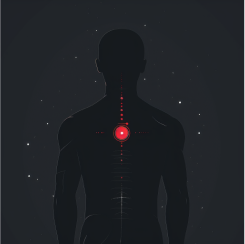
Are you often more critical of yourself than others are?


Do you feel worse before or during things that might stress you out, like appointments or social gatherings?
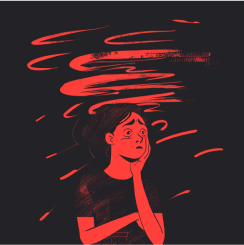

Do you obsess about your symptoms, or devote a lot of time to researching them?


Do you notice less pain or symptoms when you’re having fun or doing something enjoyable?



Are your symptoms significantly more or less intense depending on the time of day, or occur first thing in the morning or in the middle of the night?

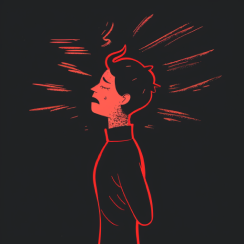
Do you experience any of the symptoms that are often neuroplastic in nature?
- Headaches
- Back pain
- Anxiety
- Depression
- Migraines
- Neck pain
- Insomnia
- Knee pain
- Brain fog
- Fibromyalgia
- Abdominal or pelvic pain
- Repetitive strain injury
- Chronic tendonitis
- TMJ (Temporomandibular Joint Disorder)
- IBS (Irritable Bowel Syndrome)
- Chronic whiplash
- Foot pain
- Vulvodynia
Would you describe yourself as highly detail-oriented or a perfectionist?


Did your symptoms start following a frightening, traumatic, or distressing event, or after an incident that triggered a past trauma?
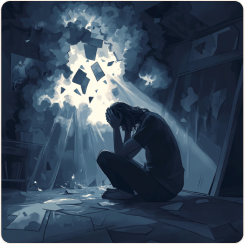

Your Score
/
We have some great news for you! According to your assessment results, latest neuroscience-based treatment has a high likelihood of successfully eliminating your pain entirely. We believe that with the right guidance and support, you’re on the path to a pain-free life. Let’s start this journey together!
Good news, Although we can’t completely exclude the possibility of other factors affecting your symptoms, neuroscience-based treatment could still play a major role in reducing your pain. By integrating this approach with personalized care, we believe you can achieve meaningful improvements. We’re with you throughout this journey.
Thank you for completing the assessment. Based on your results, there may be physical or structural causes contributing to your pain. While our neuroscience-based approach might still offer some benefit, we recommend further exploring medical treatments alongside our program. We’re here to guide and support you on this journey, whatever the next steps may be.











The Science
You may have been told otherwise, but your pain doesn’t have to be forever.
2 minute read.

So... Why Do We Feel Pain?
Pain might not seem good, but it’s actually a warning that helps keep us safe. If we burn our finger or bump our foot, pain tells us we’re hurt and something’s wrong.
Did you know?
Pain perception is not always linked to physical damage. A notable example is ‘phantom limb pain,’ where individuals feel pain in a limb that has been amputated. Despite no physical limb or injury present, the pain is very real and intense.
This happens because the brain remembers the pain paths from the now-missing limb. So, even without an limb, the brain can still make you feel pain. This shows that pain is not just about being hurt; it’s also about how the brain handles pain signals, even without actual damage.
Stress, Emotions, Pain.
Pain isn’t only caused by physical injuries; it can also result from stress and emotions. For example, when nervous about public speaking, you may experience real physical reactions like a stomachache, sweating, a rapid heartbeat, or nausea. These responses, including pain, are genuine physical reactions occurring within your body, not just something you’re imagining.
But that’s not it
Difficult childhood experiences can contribute to pain conditions later in life. For instance, animals raised in stressful environments tend to have brains that overreact to stress as adults. Similarly, people who faced challenges in childhood, such as abuse, parental separation, neglect, or school problems, are more likely to develop chronic pain conditions as adults.
It all starts with accurate knowledge
Now we know pain can start from getting hurt, feeling upset, or big changes in life.
Normally, injuries heal in three months. But sometimes, pain stays longer. Why? It’s because our brain learns and changes. When it feels pain a lot, the brain’s cells link up and get really good at noticing pain. Thus the famous neuroscience saying: “neurons that fire together wire together.” So, our brain can accidentally become better at feeling pain. Also, if we respond to pain with fear or anger, it strengthens those brain connections, making the pain feel worse and our body more sensitive to it.











Great News!
You can rewire your brain to unlearn chronic pain.
Download the PainApp now and take the
first step towards a pain-free life.
Our Cookies Care
We use cookies to make your experience smoother and more delightful.
